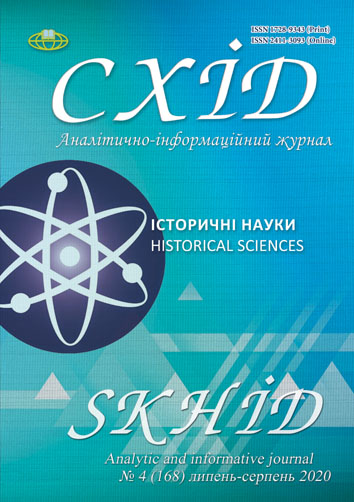Ukrainization in Kuban in the 1920s and 1930s: legitimation and delegitimation through the prism of historical memory
DOI:
https://doi.org/10.21847/1728-9343.2020.4(168).210913Keywords:
Kuban, North Caucasus, Ukrainization, national development, educationAbstract
The processes of revival of Ukrainian culture and education which unfolded among the Ukrainian population of the North Caucasus (mainly - of Kuban) in the 1920s and 1930s have been examined in the article. The scientific novelty and relevance of the study are due to the fact that, for the first time, the author has attempted to reveal the preconditions, circumstances, course and consequences of national and cultural development of the Ukrainian population in Kuban in 1920-1933 on the basis of available sources and analysis of existing literature. The reasons for this development and the structures that provided it both at the level of spontaneous initiative of local Ukrainians and due to the influence of certain official events and institutions have been highlighted in the article. Particular attention is paid to the dynamics of providing for the needs of Ukrainians in Kuban both in education in their native language and other national and cultural needs. The processes and mechanisms of transition of schools of all levels in Kuban to the Ukrainian language, creation and activity of Ukrainian-language publishing houses, theatrical, literary and musical associations have been considered. In the early 1930s, these rather large processes began to be held back by the central government. They were completely stopped at the beginning of 1933, which was accompanied by the Holodomor, the physical elimination of many Ukrainians in Kuban and assimilation de-Ukrainization processes. The reasons for this anti-Ukrainian policy and its consequences have also been considered in this article.Downloads
References
Bilyi, D. (2010). Holodomor ta polityka deukrayinizatsiyi na Kubani v 1929 - 1933 rokakh. Henotsyd Ukrayiny v XX stolitti: Materialy Vseukrayinskoyi naukovo-praktychnoyi konferentsiyi. Lviv: 364 - 376 (In Ukranian).
Makedonov, L. V. (1907). Naseleniye Kubanskoy oblasti po dannym vtorykh ekzemplyarov listov perepisi 1897. Katerinodar (In Russian).
Conquest, R. (1993). Zhnyva skorboty. Radyanska kolektyvizatsiya i holodomor. Kyiv: Vyd-vo "Lybidʹ”, 280 p. (In Ukrainian)
Sulyatytskyy, P. (1929). Ukrayinizatsiya na Kubani. Tryzub (Paryzh). 42: 16 (In Ukrainian)
Zaremba, S. (1993). Z natsionalno-kulturnoho zhyttya ukrayintsiv na Kubani. Kyyivska starovyna, 1 (In Ukrainian).
Krykulenko, V. (1990, May 10). Visti do Atlantydy. Literaturna Ukrayina (In Ukrainian).
Zastavnyy, F. D. (1992). Skhidna ukrayinska diaspora. Lviv: Svit (In Ukrainian).
Byuleteni dopomohy holoduyuchym Ukrayiny i Kubani (1933-1934). Bruxel (In Ukrainian).
Kolektyvizatsiya i holod v Ukrayini 1929 - 1933. (1992). Zbirnyk dokumentiv i materialiv. Kyiv: Naukova dumka, 736 p. (In Ukrainian).
Levchenko, V. (1989). Chernyye doski. Kuban. 7: 17 - 62 (In Russian).
Holod 1932 - 1933 rokiv na Ukrayini: ochyma istorykiv i movoyu dokumentiv (1990). Kyiv: Vydavnytstvo politychnoyi literatury Ukrayiny, pp. 291 - 294 (In Ukrainian).
Polezhayev, I. (1988, December 17). Zhivem trevozhno, no vperedi mirovaya revolyutsiya… Dnevnik iz 1933 goda. Sovetskaya Kuban. (In Russian).
Downloads
Published
How to Cite
Issue
Section
License
Copyright (c) 2020 Dmytro Bilyi

This work is licensed under a Creative Commons Attribution-NonCommercial-NoDerivatives 4.0 International License.
1. Authors bear responsibility for the accuracy of facts, quotations, numbers and names used.
2. Manuscripts are not sent back.
3. The publisher does not always agree with the authors' opinion.
4. The authors reserve the right to authorship of the work and pass the first publication right of this work to the journal under the terms of a Creative Commons Attribution-NonCommercial-NoDerivatives 4.0 International License. This license allows others to distribute (copy) the published work for non-commercial purposes, provided there is mandatory attribution to its authors and a link to the first publication in our journal.
5. The authors have the right to conclude separate supplement agreements that relate to non-exclusive work distribution in the form in which it has been published by the journal (for example, to upload the work to the online storage of the journal or publish it as part of a monograph), provided that the reference to the first publication of the work in this journal is included.

